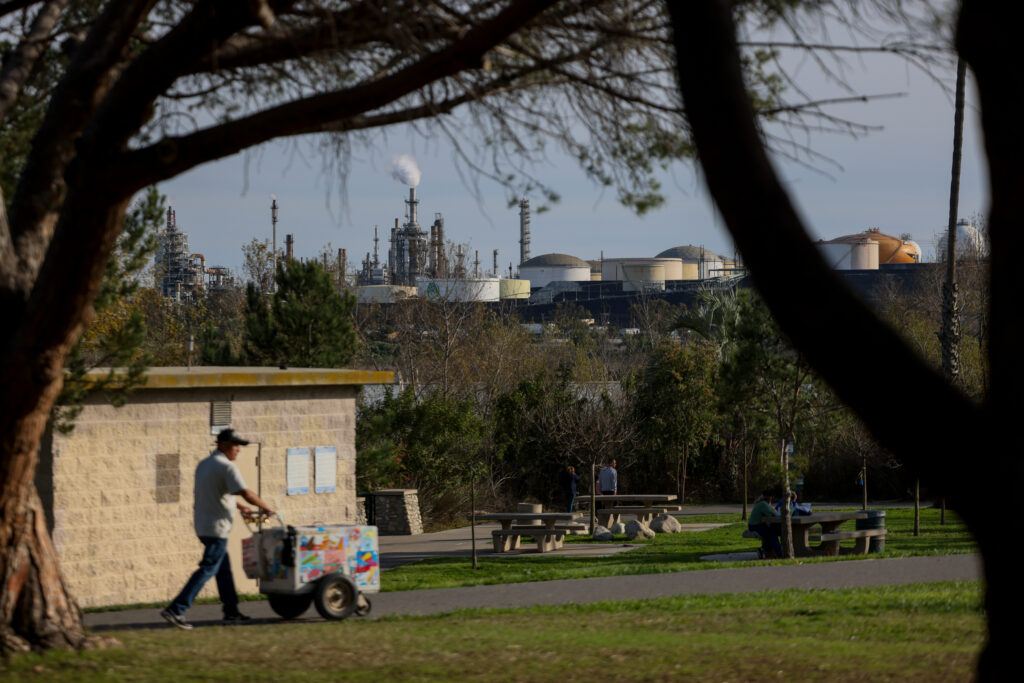CHAPEL HILL, N.C.—No dog parks. No golf. No soccer or football.
No child care centers, apartments or homes.
No community gardens unless they’re in raised beds.
The list of forbidden uses on 10 contaminated acres containing 46,000 tons of coal ash in Chapel Hill is nearly as long as what is allowed: offices, stores, municipal services, walking trails, transit and parking.
As the Town of Chapel Hill prepares to redevelop the land at 828 Martin Luther King Blvd., next to the popular Bolin Creek Greenway and less than two miles from the University of North Carolina campus, some community members and environmental lawyers say a draft cleanup plan fails to adequately protect the public from arsenic, cobalt and other toxic metals that were detected in the greenway in 2013.
Explore the latest news about what’s at stake for the climate during this election season.
Homes surround the property, and one is as close as 40 feet. Bolin Creek, which runs near the bottom of the ash mound, is 12 miles upstream of Jordan Lake, a drinking water supply for hundreds of thousands of people in central North Carolina.
Under a state-level Brownfields agreement, a prospective developer agrees to clean up a contaminated site to levels suitable for the proposed reuse, as required by the Department of Environmental Quality. In return, DEQ agrees to limit the environmental liability of the prospective developer, which makes it easier to secure financing for the project. Those responsible for the original contamination are still financially and legally liable.
Redevelopment of the site would require removal of some of the ash and grading what remains before capping it with two feet of soil, along with some eventual paving.
“Simply burying the ash under a layer of soil will do nothing to clean up the contamination and address these environmental and public health hazards,” said Perrin de Jong, Southeast staff attorney with the Center for Biological Diversity.
High levels of arsenic and radium, both linked to cancer and other serious illnesses, were detected along with 18 other toxic metals intermingled in soil and ash, according to independent sampling conducted two years ago by Duke University scientists.
Contractors hired by the town did not test for radium, but they did detect toxic metals on the property, both in shallow and deep soils, well above legal limits for residential use. Groundwater beneath the coal ash mound is also contaminated, although testing suggests the plume isn’t moving offsite. Apartments and homes near the mound are all on a public water system.
Like many communities throughout the United States, Chapel Hill officials are confronting the consequences of the nation’s dependence on fossil fuels. Continued reliance on these fuel sources drives the effects of climate change, whose price tag is in the trillions of dollars each year, if it is calculable at all.


Meanwhile, the local cost of cleaning up old contaminated sites can run in the tens of millions of dollars. Since 2013, when officials in the iconic college town found the ash on the property in preparation for a possible sale, the town spent $900,000 on addressing the contamination, including testing, partial excavation and engineering, according to town spokesperson Alex Carrasquillo.
To remove all of the coal ash from the Chapel Hill site would run upward of an additional $11 million; capping the material and building a retaining wall would cost more than $4 million, according to town figures. That’s equivalent to 2 to 7 percent of the town’s 2024-25 budget.
Those figures are only preliminary and don’t include the demolition of the Chapel Hill Police Department’s headquarters, which is built on top of some of the coal ash. Town officials told Inside Climate News that the cost “will depend on specific plans for the site, which can only come after our staff, council, and community weigh options within the terms of a final Brownfields agreement.”
DEQ is accepting public comment on the Chapel Hill draft Brownfields agreement through July 30. (Here are related documents and instructions on how to comment.)
With millions of tons of ash produced each year, power plant owners must find a way to dispose of it, either by hauling it away to landfills, keeping it in dry storage on-site or turning it into structural fill. The American Coal Ash Association estimates that a total of 180 million tons of the material have been used for fill projects throughout the U.S. since 1980: beneath parking lots, airport runways and apartment buildings, in bunkers at rifle ranges, and in farm fields.
The Chapel Hill ash originated at a UNC steam plant from the 1950s to the 1970s. Tons of ash were legally dumped into a pit at 828 Martin Luther King Blvd. to serve as fill dirt mixed with construction debris and even household trash.
The UNC steam plant still burns coal, as well as natural gas. It generates about 10,000 tons of combustion byproducts annually, according to the university’s media relations department, “with only a third being coal ash due to our emissions reduction efforts.”
The material is then shipped to Virginia, where it’s used as structural fill for reclaiming land at a municipal landfill, “providing a stable base for possible future redevelopment,” according to the university.
Chapel Hill officials purchased the 828 site, as it’s known locally, in 1980 to build the town’s police station. The property is one of at least 79 structural fill sites in the state containing nearly 9 million tons of coal ash. That’s likely an undercount. DEQ records only those sites with more than 10,000 cubic yards of ash. And because DEQ didn’t begin tracking the locations until 1994, an untold number of sites have not been documented.
This story is funded by readers like you.
Our nonprofit newsroom provides award-winning climate coverage free of charge and advertising. We rely on donations from readers like you to keep going. Please donate now to support our work.
Donate Now
Extreme weather can expose coal ash in myriad ways. Over time, heat and rain can crack pavement, which has occurred at two commercial parking lots in Mooresville.
Flooding can also destabilize steep slopes of ash and release the material into surface water and groundwater. Of North Carolina’s known structural fill sites, roughly half, including the 828 site, lie within a quarter mile of a 100- or 500-year flood plain, according to state data. This means the annual chances of inundation range from 1 percent to 0.2 percent. However, as storms intensify because of climate change, many areas that rarely flooded now do so.
Coal ash is notoriously unstable, “and prone to sinkholes and collapses,” said Nick Torrey, an attorney with the Southern Environmental Law Center, which is representing the Friends of Bolin Creek. “Leaving unstable coal ash in place is too dangerous for Chapel Hill.”
If Chapel Hill officials choose to keep the ash and contaminated dirt in place rather than remove it, the property must be capped with at least 2 feet of clean soil, according to a draft Brownfields agreement between the town and state environmental regulators. A retaining wall could also be built to prevent the ash from sliding down steep slopes and onto the greenway or Bolin Creek. Groundwater use would be prohibited. The land restrictions would be in perpetuity.


By removing, grading and capping the ash mound, the town could reuse the property, albeit in limited ways. A small forest edges a portion of the ash mound. State officials have recommended that those trees stay intact to prevent the ash from escaping.
That has already occurred several times. Over the past 10 years, ash from the mound has wound up along the greenway. In 2016, soil samples in publicly accessible areas showed elevated levels of arsenic, cobalt and selenium, among other metals, above health-based standards.
In 2020, in Chapel Hill officials hired contractors to excavate 1,000 tons of the material that had become unstable on the steep slopes. Earlier this year, more ash had accumulated at the bottom of the embankment, against a silt fence and close to the greenway. That ash was also removed. A chain-link fence has been installed outside the silt fence.
A small sinkhole has already opened on the Chapel Hill property, next to the police station parking lot, state records show. Contractors filled it with rocks and covered it with dirt.
“This is not a responsible, safe approach,” Torrey said, “and it indicates that the town’s current agreement and plan to cover the coal ash with dirt will not ensure the public and natural environment are safe.”
About This Story
Perhaps you noticed: This story, like all the news we publish, is free to read. That’s because Inside Climate News is a 501c3 nonprofit organization. We do not charge a subscription fee, lock our news behind a paywall, or clutter our website with ads. We make our news on climate and the environment freely available to you and anyone who wants it.
That’s not all. We also share our news for free with scores of other media organizations around the country. Many of them can’t afford to do environmental journalism of their own. We’ve built bureaus from coast to coast to report local stories, collaborate with local newsrooms and co-publish articles so that this vital work is shared as widely as possible.
Two of us launched ICN in 2007. Six years later we earned a Pulitzer Prize for National Reporting, and now we run the oldest and largest dedicated climate newsroom in the nation. We tell the story in all its complexity. We hold polluters accountable. We expose environmental injustice. We debunk misinformation. We scrutinize solutions and inspire action.
Donations from readers like you fund every aspect of what we do. If you don’t already, will you support our ongoing work, our reporting on the biggest crisis facing our planet, and help us reach even more readers in more places?
Please take a moment to make a tax-deductible donation. Every one of them makes a difference.
Thank you,

















